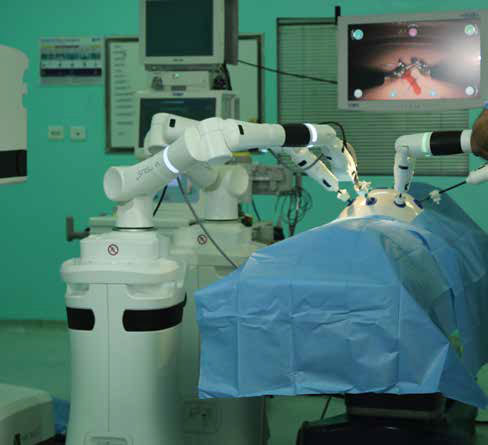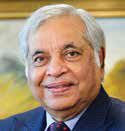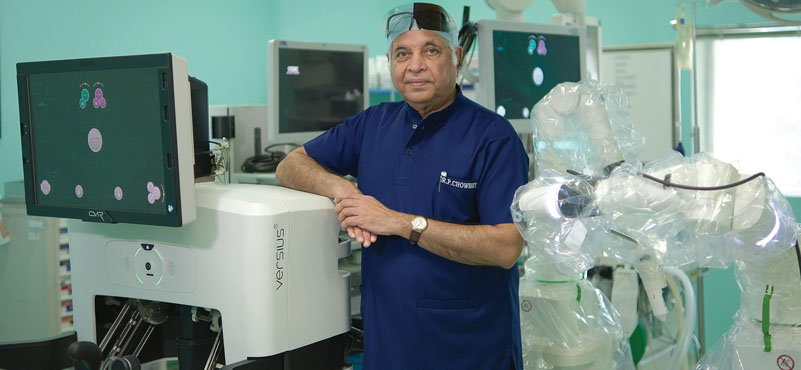LIKE LAPAROSCOPY WAS INTRODUCED SOME 30 YEARS AGO!
New Generation robotic surgery is the new ‘IN’ thing in medicine. And, Max Saket is leading in this field, to begin with, in abdominal related surgeries, under leading surgeon Dr. Pradeep Chowbey. “It was important to bring this new equipment at the right time or we miss the bus in being the first mover. It was introduced globally in 2019, when covid struck its progress to get picked up. We started operating with it in 2021. It has been over a year now,” says Chowbey in an exclusive interview.
This is one more leap for you personally, and for the hospital. Robotics, of the new generation, in your field, has created a new stir in medicine. What is this machine called?
This is a next generation platform for surgical procedures.
For a layman point of view, how is robotics or robotic surgery an improvement over traditional surgery?
The biggest improvement is that traditional laparoscopy is a two-dimensional surgery. As if you are operating by looking at the mirror. Whereas robotic surgery is three dimensional, as we are sitting like this, between us, face to face. So, the depth perception is very precise.
It is like us sitting here physically vs sitting virtually. It is like going from virtual to physical. You feel you are sitting in the organ you are operating on.
But in the earlier or in the traditional laparoscopy, your intervention as surgeon and your intervention as surgeon in robotic surgery. Is that the same element?
It is much more refined, much more precise, much safer. I am the one whom is operating. But I am not standing next to the patient. There is a console. Because the robotic arms are there, with the instruments in it.
So, you need to practice the use of the robotic arm?
Yeah. It is like moving from car driving to aircraft flying, and you get a third dimension also. It is a conversion or you can say upgradation.
So, what course do you go through?
I went to Cambridge, then we went to Dubai. And then there are simulators, like flying simulators are there. Second is that in conventional laparoscopy, the surgeons’ movements are restricted by the wrist because the wrist has got limited movement. And in conventional surgery we use elbow and shoulder also.
So basically, does anybody else have this in Delhi or this is Max Saket only?
Max Saket. And I want to mention, please don’t get confused. This is the next generation robotic system. Not the first generation.
Which means?
What we are using is the Cambridge Medical Robotics, it is from European Cambridge. So, this is the next generation. It is similar to how now you use a smart TV. Both are TVs, but this is the next gen TV. And the wrist movements get more precise. Like stitching in three dimensional is a lot more precise.
Now you said this is mobile, which means you can take it from one OT to another OT.
Yes, so you don’t waste time. It can be used in different OTs, it is not restricted physically to only one.
So, there are other surgeons also using the same?
Currently not, but there is a possibility. The gynecologist, anyone can eventually use.
So, at the moment is being used only by you?
Yes, because my workload is here. I am doing almost 80-100 robotics surgeries out of the 350 that I do in a month. We use 5 operation threatres; when you finish one surgery, the other OT is already prepped and ready.
So typically, you are working from what time to what time on an average?
From about 9.30am to 8.30pm. But I operate till about 3pm and then have appointments and follow ups and take rounds.
Does it cost more to do the robotic surgery?
About rupees 60-65000 more. About 20 to 25% more. This is due to the sterile environment required around it.
You are said to be the first person to have done the fastest first hundred Robotic surgeries. And, found place one more time in the Limca Book of records?
There are 2 reasons for this. There is a background. I have the experience with me behind me, done almost 95,000 laparoscopic surgeries in last 33 years. I do about 4000 a year. So, for me adapting has been that much easier.
You mentioned that the patient must opt for a robotic surgery? So, is there a reservation with patients?
No. Not among patients. Mostly, the reservations are with some insurance company which are not yet paying for robotic surgery, which I feel is a temporary phenomenon. They can’t hold on for long when it comes to providing a better and safer surgery.
So if you are doing 350 earlier, the traditional laparoscopic, how many do you think you can do now?
Eventually, with an increase in efficiency using robotic technology, one can do more. It is quite likely. The tiredness is less and the average time taken is less.
When do you expect that the other departments will start using it?
I think some of the other departments have started using, but as I said, they are using the first generation. This is a special next generation robotic system, which is more friendly for quick surgeries. It is coming to every specialty and that robot might be different. Every specialty has got a different requirement. And for that there is different machine. Robotics guides you for more precision. Apart from any clinical judgement you are adding the robotic judgement.
What likely impact do you see that is forthcoming?
 35 years back we moved from conventional surgery to laparoscopic surgery and now the future is in robotics surgery. From the surgeon’s point of view, also, it is a great advantage because you are not working, looking in the mirror. You are almost sitting inside the abdominal cavity.
35 years back we moved from conventional surgery to laparoscopic surgery and now the future is in robotics surgery. From the surgeon’s point of view, also, it is a great advantage because you are not working, looking in the mirror. You are almost sitting inside the abdominal cavity.
When you said this big change is going to happen from laparoscope to robotic laparoscopy, how do you see the increasing penetration of the market from robotic surgery?
See, I think this exactly, what we have gone through 35 years back when we were asked the same question, how do you see the penetration of laparoscopic surgery? It was also more expensive due to the instruments. The camera systems were expensive. So, there was a big question, but over time we realized that this question was more theoretical or political in nature.
This would then be the big new moment in transition?
You see within our own generation; we have seen how things have moved. For example, in aviation, everybody is travelling by air. So now what is happening is that now, maybe the robotic systems are expensive, but there are almost 17, 18 companies which are making it. And they are making specialized robots for each kind of surgery.
Which countries would these be?
All over the world. Japanese, Korean, US, Germany, and a few more.
You think the cost of it will come down?
Drastically. For two reasons. First, popularity and it is a better way of operating, more precise. It is also safer because there are inherent artificial intelligence and machine learning in the robotic system. So, this makes surgery even safer. It reduces human error. As the advantages dawn upon more hospitals, worldwide, there would be greater demand, and volumes will grow. Effectively, prices will come down.
For example, suppose some instrument is not under the camera vision. Any tip of any instrument. Then the system will not work. So, if there are four instruments inside, if the robotic screen does not detect four, it freezes. If some instrument is pressing on some particular organ more than it should, then that instrument will freeze. Then you have to react to it. Which will go undetected in a non-robotic surgery.
Being the first movers, how does it feel? How has the progress been in our country?
Well, every now and then, we get people calling us to get feedback from us. From the time we got into this, I think some 40 more machines have been purchased around the country. It is an expensive machine and it must justify this expenditure for every institution.
You have done some 95,000 surgeries over your career. When do you achieve the next milestone?
I think, given that we are doing some 3,500/4000 in a year, we are hopeful we would have done 1 lakh surgeries by the end of 2024. That should be the milestone year.
How has it been for Max?
I think we are quite happy with it.
ABOUT:
 Dr. Pradeep Chowbey is chairman, Max Institute of Laparoscopy, Endoscopy, Bariatric, Gastrointestinal and Allied Surgical Specialities, Max Healthcare, New Delhi. He recently clocked another world record with 623 robotic surgeries in a year. He was recently described as the “legendary surgeon of kind cuts”.
Dr. Pradeep Chowbey is chairman, Max Institute of Laparoscopy, Endoscopy, Bariatric, Gastrointestinal and Allied Surgical Specialities, Max Healthcare, New Delhi. He recently clocked another world record with 623 robotic surgeries in a year. He was recently described as the “legendary surgeon of kind cuts”.




































